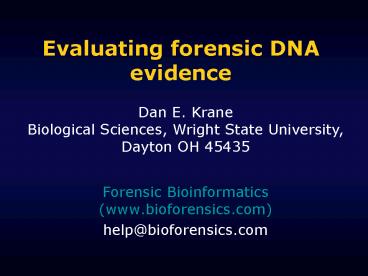Evaluating forensic DNA evidence - PowerPoint PPT Presentation
1 / 34
Title:
Evaluating forensic DNA evidence
Description:
Electrophoresis. A technique for separating molecules according to their size. STR ... Capillary Electrophoresis. Amplified STR DNA injected onto column ... – PowerPoint PPT presentation
Number of Views:76
Avg rating:3.0/5.0
Title: Evaluating forensic DNA evidence
1
Evaluating forensic DNA evidence
Dan E. Krane Biological Sciences, Wright State
University, Dayton OH 45435
- Forensic Bioinformatics (www.bioforensics.com)
- help_at_bioforensics.com
2
Three generations of DNA testing
DQ-alpha TEST STRIP Allele BLUE DOT
RFLP AUTORAD Allele BAND
Automated STR ELECTROPHEROGRAM Allele PEAK
3
DNA content of biological samples
Type of sample
Amount of DNA
Blood
30,000 ng/mL
2
stain 1 cm in area
200 ng
2
stain 1 mm in area
2 ng
Semen
250,000 ng/mL
Postcoital vaginal swab
0 - 3,000 ng
Hair
plucked
1 - 750 ng/hair
shed
1 - 12 ng/hair
Saliva
5,000 ng/mL
Urine
1 - 20 ng/mL
4
Basic terminology Genetics
- DNA Polymorphism (many forms)
- Regions of DNA which differ from person to person
- Locus (plural loci)
- Site or location on a chromosome
- Allele
- Different variants which can exist at a locus
- DNA Profile
- The combination of alleles for an individual
5
Basic terminology Technology
- Amplification or PCR (Polymerase Chain Reaction)
- A technique for replicating DNA in the
laboratory (molecular Xeroxing) - Region to be amplified defined by PRIMERS
- Can be color coded
- Electrophoresis
- A technique for separating molecules according to
their size
6
STR
- Short tandem repeat
- Describes a type of DNA polymorphism in which
- a DNA sequence repeats
- over and over again
- and has a short (usually 4 base pair) repeat unit
- A length polymorphism -- alleles differ in their
length
3 repeats AATG AATG AATG
4 repeats AATG AATG AATG AATG
5 repeats AATG AATG AATG AATG AATG
6 repeats AATG AATG AATG AATG AATG AATG
7
Reading an electropherogramPeaks correspond to
alleles
8
Automated STR Test
9
Crime Scene Samples Reference Samples
- Extract and purify DNA
- Differential extraction in sex assault cases
separates out DNA from sperm cells
10
Extract and Purify DNA
- Add primers and other reagents
11
PCR Amplification
- DNA regions flanked by primers are amplified
- Groups of amplified STR products are labeled
with different colored dyes (blue, green, yellow)
12
The ABI 310 Genetic AnalyzerSIZE, COLOR
AMOUNT
13
ABI 310 Genetic Analyzer Capillary
Electrophoresis
- Amplified STR DNA injected onto column
- Electric current applied
- DNA pulled towards the positive electrode
- DNA separated out by size
- Large STRs travel slower
- Small STRs travel faster
- Color of STR detected and recorded as it passes
the detector
14
Profiler Plus Raw data
15
Statistical estimates the product rule
0.222
0.1
16
Statistical estimates the product rule
1 in 10
0.1
1 in 79,531,528,960,000,000
1 in 80 quadrillion
17
What more is there to say after you have said
The chance of a coincidental match is one in 80
quadrillion?
18
What more is there to say after you have said
The chance of a coincidental match is one in 80
quadrillion?
- Two samples really do have the same source
- Samples match coincidentally
- An error has occurred
19
Sources of ambiguity in DNA testing results
- Stutter (n4)
- Pull-up
- Degradation, inhibition
- Background noise
- Spikes and blobs
- Mixtures relatives and deconvolution
20
Opportunities for subjective interpretation?
21
Opportunities for subjective interpretation?
D3 12, 17 vWA 15, 17 FGA 22, 26
22
Background noise
23
Stutter peaks
24
Pull-up (software differences)
Classic
Advanced
25
Degradation
LARGE
SMALL
- When biological samples are exposed to adverse
environmental conditions, they can become
degraded - Warm, moist, sunlight, time
- Degradation breaks the DNA at random
- Larger amplified regions are affected first
- Classic ski-slope electropherogram
- Degradation is unusual.
26
Degradation
The Leskie Inquest
- Undegraded samples can have ski-slopes too.
- How negative does a slope have to be to an
indication of degradation? - Experience, training and expertise.
- Positive controls should not be degraded.
27
Degradation
The Leskie Inquest
- DNA profiles in a rape and a murder investigation
match. - Everyone agrees that the murder samples are
degraded. - If the rape sample is degraded, it could have
contaminated the murder samples. - Is the rape sample degraded?
28
Degradation
The Leskie Inquest
29
Spikes and blobs
blob
Peak area
spike
Peak height
30
Mixed DNA samples
31
How many contributors to a mixture?
How many contributors to a mixture if analysts
can discard a locus?
There are 45,139,896 possible different 3-way
mixtures of the 648 individuals in the MN BCI
database.
32
Accounting for relatives
33
Resources
- Books
- Forensic DNA Typing by John M. Butler (Academic
Press) - Internet
- Applied Biosystems Website http//www.appliedbios
ystems.com/ (see human identity and forensics) - Promega Website http//www.promega.com/ (see
Genetic Identity) - STR base http//www.cstl.nist.gov/biotech/strbase
/ (very useful) - Scientists
- Larry Mueller (UC Irvine)
- Simon Ford (Lexigen, Inc. San Francisco, CA)
- William C. Thompson (UC Irvine)
- William Shields (SUNY, Syracuse, NY)
- Marc Taylor (Technical Associates, Ventura, CA)
- Carll Ladd (Connecticut State Police)
- Testing laboratories
- Technical Associates (Ventura, CA)
- Forensic Analytical (Haywood, CA)
- Other resources
- Forensic BioInformatics (Dayton, OH)
34
Likelihood ratios for allele sharing











![DNA EVIDENCE [SC Rule On DNA Evidence] ACA Nimfa Cuesta Vilches PowerPoint PPT Presentation](https://s3.amazonaws.com/images.powershow.com/3895057.th0.jpg?_=20201020101)


















